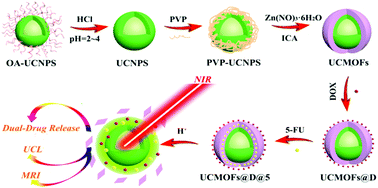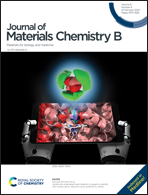Heterodimers made of metal–organic frameworks and upconversion nanoparticles for bioimaging and pH-responsive dual-drug delivery†
Abstract
Developing multifunctional nanocomposites for a pH-responsive controlled dual-drug delivery is still a huge challenge. Herein, we report a gentle and simple method for growing metal–organic frameworks (MOFs) that can load two anticancer drugs, namely DOX and 5-FU (doxorubicin and 5-fluorouracil), on the surface of upconversion nanoparticles (UCNPs) by the reactions of Schiff bases and electrostatic adsorption. The resulting pH-responsive UCMOFs@D@5 nanosystem showed effective dual-drug release by the cleavage of chemical bonds and the disruption of the MOF structure under acidic conditions. Moreover, the final nanosystem UCMOFs@D@5 showed much higher cytotoxicity in comparison with UCMOFs@D and UCMOFs@5, which loaded only one kind of drug, respectively, after being incubated with human cervical cancer (HeLa) cells, indicating that Dox and 5-FU released from the final nanosystem had synergistic effects on cytotoxicity. Cellular uptake studies showed that UCMOFs@D@5 was well uptaken by HeLa cells and has potential for bioimaging applications in intracellular fluorescence imaging with high-contrast, and is beneficial for the intracellular localization of anti-cancer drugs. In addition, the nanosystem can be successfully applied in T1-weighted magnetic resonance imaging. Therefore, we developed a visualized tracking agent combined with MOFs to load two anticancer drugs to form a nanosystem for diagnosis and synergistic treatment, thus achieving the bioimaging and stimulation-responsive dual-drug release.



 Please wait while we load your content...
Please wait while we load your content...